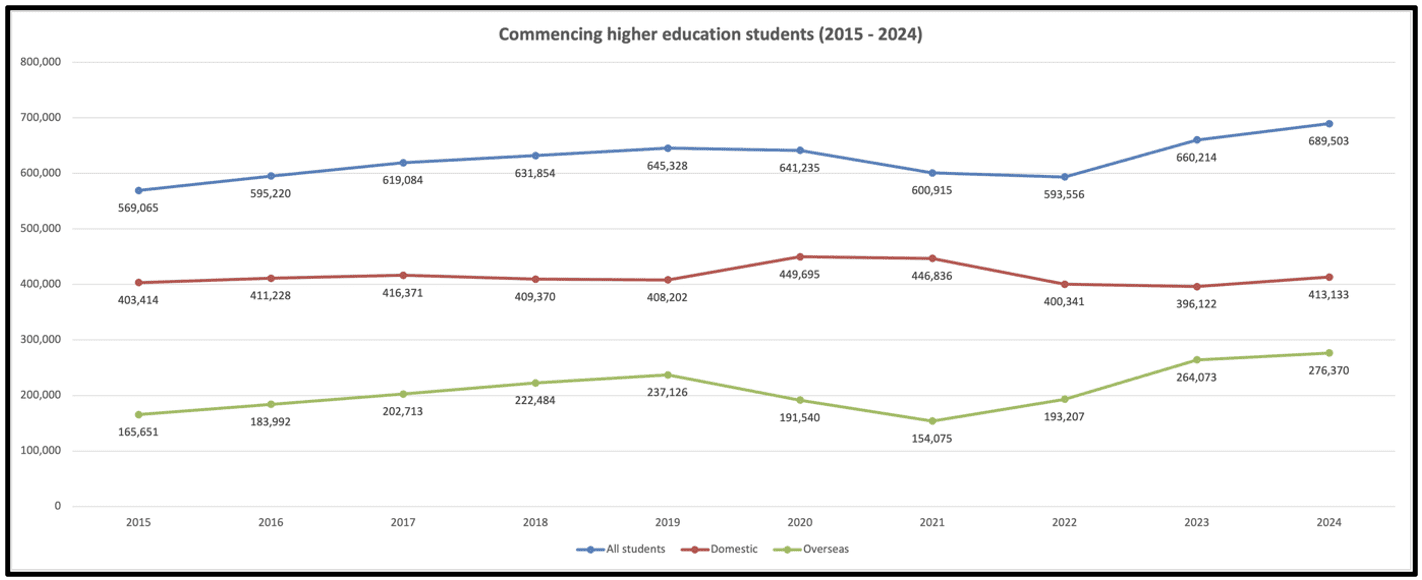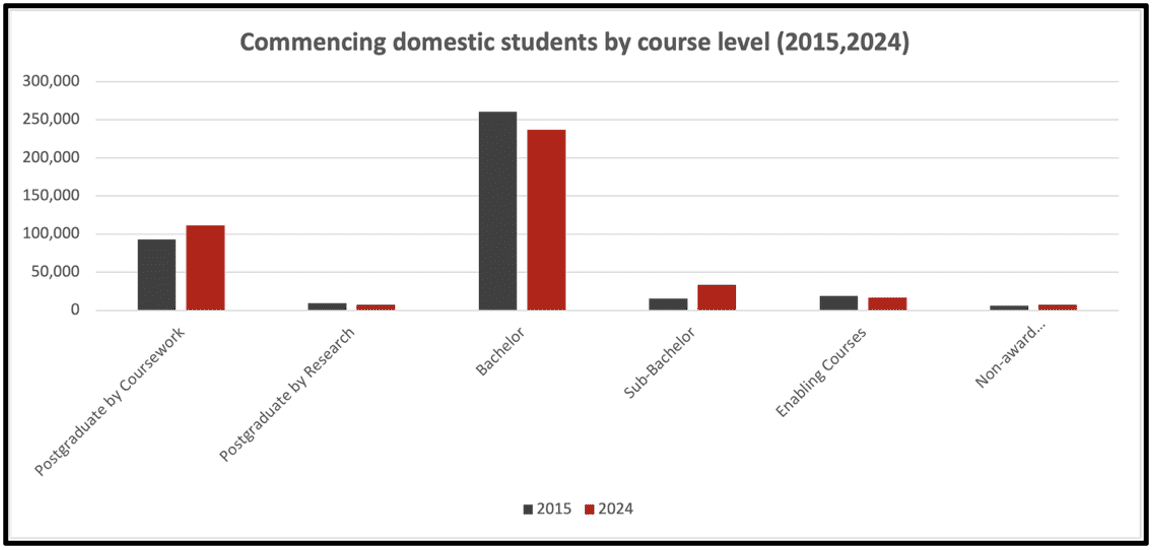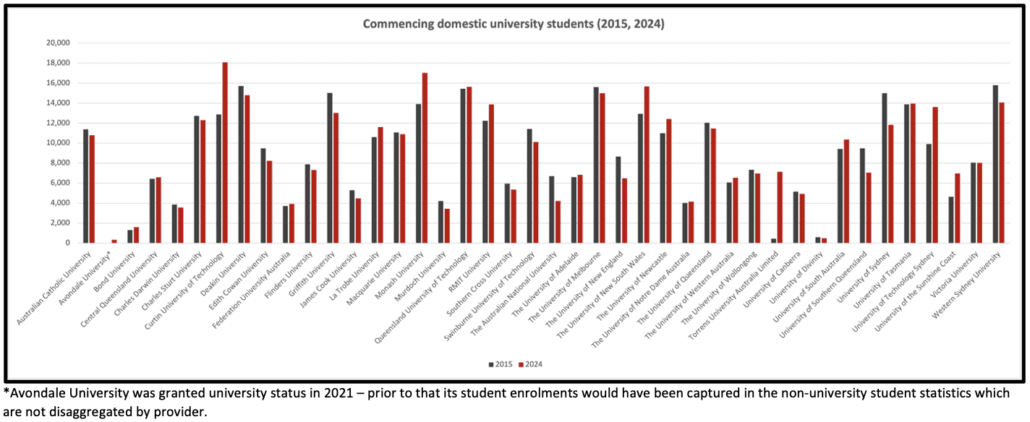Australia’s 15 new private higher education providers
/in News/by cfa_6vgcb7 Australia’s 15 new private higher education providers
Australia’s 15 new private higher education providers
As 2025 draws towards a close and with TEQSA’s annual report for 2024-25 having recently been released, it is interesting to reflect on the changes which have happened in the last two years in the Australian higher education sector.
The sector is undergoing a period of significant change. Some of that change is deliberate – arising from the government’s Universities Accord Panel process and the implementation of some of the recommendations from the Panel’s final report, and from the government’s attempts to cap international student enrolments. Other changes have arisen because of concerns about the scale of wage underpayments in the sector and related governance issues in some institutions which have come to light in media reports and the current Senate inquiry.
As universities and non-university higher education providers (NUHEPs) seek to navigate this changing sector – there has been almost no attention given to if, and how, the providers operating in the sector are changing.
The only ‘new’ provider most people in the sector would be aware of is Adelaide University – the merger of the University of Adelaide and the University of South Australia.
In fact, in addition, to Adelaide University there have been 15 other providers granted initial registration by TEQSA since January 2024. In a sector with only 215 providers in total – the fact that 7% of the providers in the sector are new – is interesting.
While these new providers are obviously all much smaller institutions than a new publicly-funded university created from a merger of two long-established universities – the significant time and costs involved in establishing new private higher education providers means that the fact that so many are being established, despite the decline in international education and the Universities Accord Panel being almost entirely focussed on publicly-funded universities, makes them worthy of consideration.
Characteristics of the new providers
More than half (8) are based in Sydney (which continues the trend seen in the latest higher education statistics showing two-thirds of all students studying with NUHEPs are in New South Wales). The other new providers have established themselves in:
- Melbourne (4)
- Brisbane (2)
- Adelaide (1)
Nine of the 15 have CRICOS approval to teach international students, and they are mostly delivering business and technology-related degrees (with two also entering the early childhood sector – which is interesting timing given TEQSA is currently very focussed on providers teaching early childhood given academic integrity concerns – in universities and NUHEPs). The courses on offer from the new CRICOS-approved providers are:
- Bachelor of Technology (Electric Vehicle)
- Bachelor of Business and Master of Professional Accounting (Advanced)
- Bachelor of Business, Master of Business, Master of Business Administration, Graduate Certificate of Business, Graduate Diploma of Business
- Bachelor of Engineering (Honours) Networking and Internet of Things, Bachelor of Networking and Internet of Things, Associate Degree of Networking and Internet of Things, Diploma of Applied Technology
- Bachelor of Business Administration, Graduate Diploma of Early Childhood Education
- Bachelor of Business (Accounting), Master of Business Administration, Master of Business Research, Graduate Diploma of Early Childhood Education
- Bachelor of Accounting
- Bachelor of Information Technology
- Bachelor of Business
The providers which are focussed solely on domestic students have the following courses on scope:
- Bachelor of Information Technology and Cybersecurity
- Bachelor of Culinary Arts Business Management
- Bachelor of Information Technology and Innovation, Master of Information Technology and Innovation
- Master of Cyber Security, Graduate Certificate of Cyber Security, Graduate Diploma of Cyber Security
- Bachelor of Community Services, Graduate Diploma in Early Childhood Teaching
- Bachelor of Human and Community Services, Master of Business Administration (Health Services Management), Graduate Certificate in Health Services Management
The domestic students studying at these providers will not be eligible for government subsidies for their courses or more generous HECS-HELP student loans. Therefore typically NUHEPs teaching domestic students have relied on innovation and differentiation to attract their students. Some of these courses sound similar to those on offer in publicly-funded universities, and it therefore may be that the differentiation in the courses being offered may lie in how the courses are taught and/or the providers’ industry-links. The business plans and financial modelling of all new providers are carefully considered by TEQSA as part of the initial registration process.
Interestingly, none of these new providers are RTOs – reflecting a further shift away from established patterns in the higher education sector where previously a relatively high proportion of new providers entered the higher education sector having started first in VET.
At the same time that these new providers have entered the sector since January 2024, five providers have exited:
- Carnegie Mellon University (Adelaide)
- International Institute of Business and Technology (Australia) Pty Ltd (Perth)
- Kontea Pty Ltd trading as Australian Industrial Systems Institute (Melbourne)
- The Australasian College of Dermatologists (St Leonards, Sydney)
- BBI The Australian Institute of Theological Education (Pennant Hills, Sydney) – now part of the Australian University College of Divinity
One of these exiting providers was also an RTO.
So in the last two years – we now have one fewer dual sector-provider and one fewer provider in Perth. Small changes of course, but worth keeping an eye on in a relatively small sector (by provider numbers) as governments focus on increased tertiary harmonisation and as the publicly-funded university sector in Western Australia undergoes significant change due to planned university mergers.
















